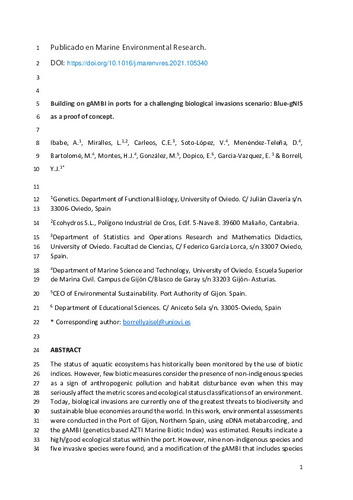Building on gAMBI in ports for a challenging biological invasions scenario: Blue-gNIS as a proof of concept
Fecha de publicación:
Versión del editor:
Citación:
Resumen:
The status of aquatic ecosystems has historically been monitored by the use of biotic indices. However, few biotic measures consider the presence of non-indigenous species as a sign of anthropogenic pollution and habitat disturbance even when this may seriously affect the metric scores and ecological status classifications of an environment. Today, biological invasions are currently one of the greatest threats to biodiversity and sustainable blue economies around the world. In this work, environmental assessments were conducted in the Port of Gijon, Northern Spain, using eDNA metabarcoding, and the gAMBI (genetics based AZTI Marine Biotic Index) was estimated. Results indicate a high/good ecological status within the port. However, nine non-indigenous species and five invasive species were found, and a modification of the gAMBI that includes species invasiveness was proposed: Blue-gNIS. The index was preliminary tested against existing validated indices such as gAMBI, BENTIX (based on the ecology of macroinvertebrates) and ALEX (based on the invasiveness of the species). Blue-gNIS classified the port in a good ecological status and showed its potential usefulness to achieve more complete water quality assessments of ports.
The status of aquatic ecosystems has historically been monitored by the use of biotic indices. However, few biotic measures consider the presence of non-indigenous species as a sign of anthropogenic pollution and habitat disturbance even when this may seriously affect the metric scores and ecological status classifications of an environment. Today, biological invasions are currently one of the greatest threats to biodiversity and sustainable blue economies around the world. In this work, environmental assessments were conducted in the Port of Gijon, Northern Spain, using eDNA metabarcoding, and the gAMBI (genetics based AZTI Marine Biotic Index) was estimated. Results indicate a high/good ecological status within the port. However, nine non-indigenous species and five invasive species were found, and a modification of the gAMBI that includes species invasiveness was proposed: Blue-gNIS. The index was preliminary tested against existing validated indices such as gAMBI, BENTIX (based on the ecology of macroinvertebrates) and ALEX (based on the invasiveness of the species). Blue-gNIS classified the port in a good ecological status and showed its potential usefulness to achieve more complete water quality assessments of ports.
ISSN:
Patrocinado por:
This study has been supported by the Spanish Ministry of Economy and Competitiveness and Asturias Government with the Project MINECO-17-CGL2016-79209-R. Prof. Carleos C. was funded through the project MINECO-16-MTM2015-63971-P. Authors would like to thank the support from the authorities from the Port of Gijon. This is a contribution of the Marine Observatory of Asturias (OMA). A. Ibabe hold an FPI fellowship from Spanish Government.
Colecciones
- Artículos [37321]
- Biología Funcional [792]
- Investigaciones y Documentos OpenAIRE [8276]
Ficheros en el ítem





